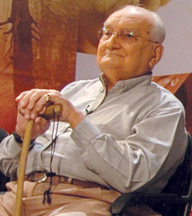Finally free to roam the skies forever...
by Nalaka GUNAWARDENE
|

Ray Wijewardene |
I went straight from a paddy field, where I was filming much of the
morning, to the funeral of my mentor and friend Ray Wijewardene early
afternoon at the General Cemetery, Colombo.
Ray would have approved: despite being a high flyer in every sense of
that phrase, he had his feet firmly on the ground - and sometimes in the
mud. He was fond of saying, "Agriculture is my bread and butter, while
aviation is the jam on top of it".
Dr. Philip Revatha (Ray) Wijewardene, who passed away on August 18
aged 86, was an accomplished engineer, aviator, inventor, Olympian and a
public intellectual of the highest calibre. He was also one of the most
practical and down to earth people I've known.
He preferred to introduce himself as a farmer and mechanic who still
got his hands dirty'. Perhaps that's how he wanted to be remembered -
but each one of us will carry our own vivid memories of this colourful,
jovial and altogether remarkable human being.
Ray just loved to fly. Most humans share this age old dream, but Ray
wasn't contented just being flown around on commercial jets - which to
him were merely large, sealed up cylinders. He far preferred the small,
propeller-driven aircraft - single or twin seaters that gave their
passengers a true sense flying and a real taste of the sky.
Looking back, it was quite apt that I first met Ray at the Ratmalana
Airport, just south of Colombo, from where he took off and landed
hundreds of times over the decades. One sunny morning in mid 1986, he
took time off from his flying to talk to a group of high school leavers
who were participating in the first Science for Youth program. It
exposed us to various (then) modern technologies over six consecutive
weekends. Much of the knowledge we gained has long been obsolete, but
its inspirational value was timeless....and continues to propel me
forward.
Much of that inspiration came from Ray Wijewardene, who talked to us
- with lots of practical demonstrations - about problem solving and
innovations in three areas close to his heart: energy, agriculture and
transport. I remember how he was experimenting with improvements to the
humble bicycle at the time, so that riders could optimise performance
with modest efforts.
He also talked about growing our food and energy. But it was his
flying experience that most fascinated us starry-eyed youngsters. As a
pilot, Ray was licensed to fly three kinds of flying machines:
fixed-wing aircraft, helicopters and autogyros.
But this pilot was flying not only factory-fitted, mass-manufactured
units. He also experimented with building and flying his own ultra-light
aircraft and helicopters - he was particularly interested in building
amphibious small planes that could land on, and take off from, Sri
Lanka's numerous inland lakes and reservoirs.
When he was approaching 75, Ray told me how nervous he was when he
had to go for renewals of his pilot's licence. In the end, it wasn't age
that ended his flying career: along with everyone else, he was
'grounded' when private flying was first restricted and then banned
during the latter years of Sri Lanka's long-drawn war.
During the 1990s, Ray had repeatedly invited me to share a flight on
one of his home-built light planes. He assured me they were perfectly
safe - among satisfied customers was Prof Cyril Ponnamperuma, one time
science advisor to the President of Sri Lanka and an internationally
renowned biochemist.
Gravity, bureaucracy and age may have conspired to keep Ray confined
to the ground in the last few years of his life - but only just. His
spirit soared even when the body wasn't allowed to: in all my years and
encounters with him, I've never seen him 'down' (concerned and
reflective, yes; depressed, no).
That passion, enthusiasm and spirit of adventure characterised Ray
and influenced everything he did, on the ground and in the air. Born in
the 1920s and raised as part of the first generation of humans for whom
private flying was available, he was infected with the 'flying bug' in
the same way that American author and aviator Richard Bach was. In fact,
Ray knew Bach and was a devoted fan of the latter's books, especially
Jonathan Livingston Seagull.
Ray wasn't a loner (to the contrary, he was very much a team player
in everything he did). But sometimes he was racing ahead of us - or just
flying at a higher altitude. Although I've never heard him say it,
perhaps this unattributed quote partly explains the phenomenon: "When
once you have tasted flight, you will forever walk the earth with your
eyes turned skyward, for there you have been, and there you will always
long to return."
What Ray did quote, frequently, were these words of Robert Browning:
"Ah, but a man's reach should exceed his grasp, or what's a heaven for?"
On returning from the simple yet moving funeral, I Tweeted: No longer
a prisoner of gravity: sky-lover, pilot & light aircraft builder Ray
Wijewardene blasted off heavenwards. Farewell, high flyer! |

